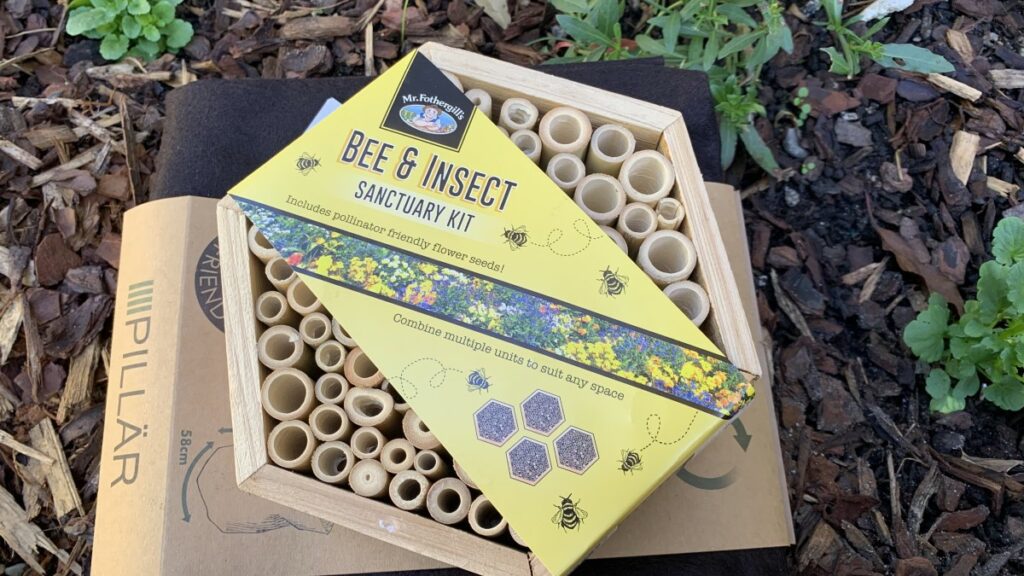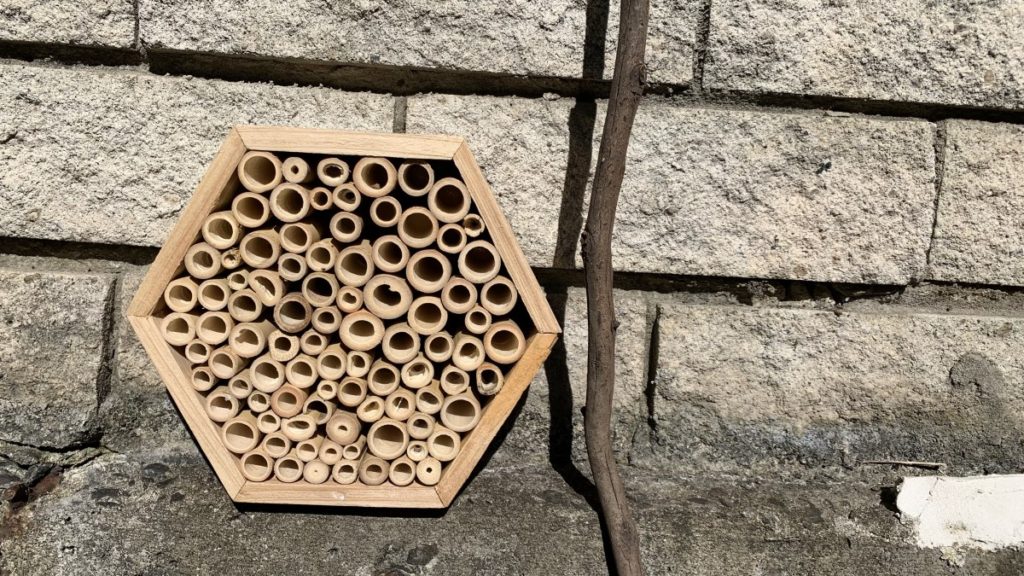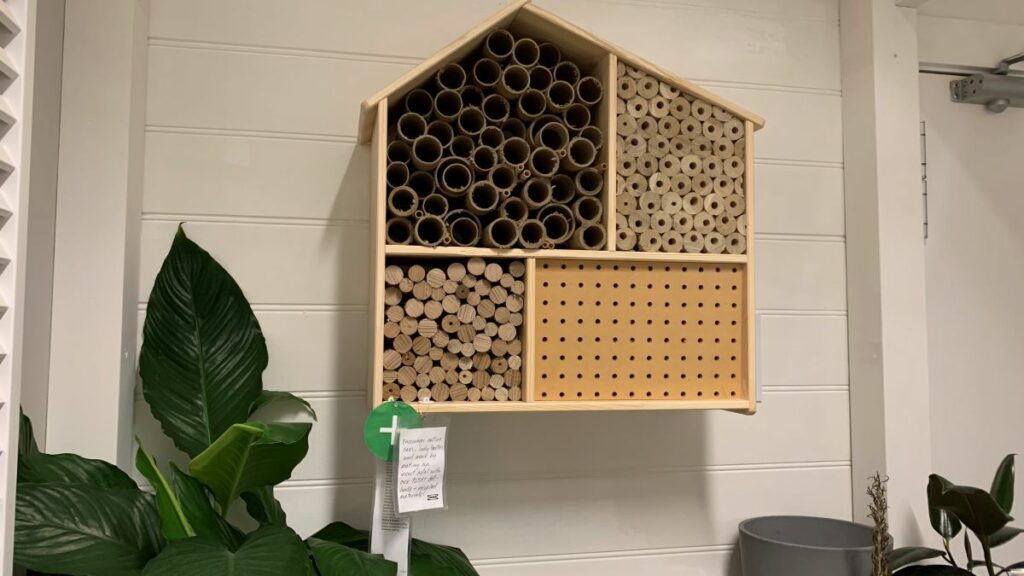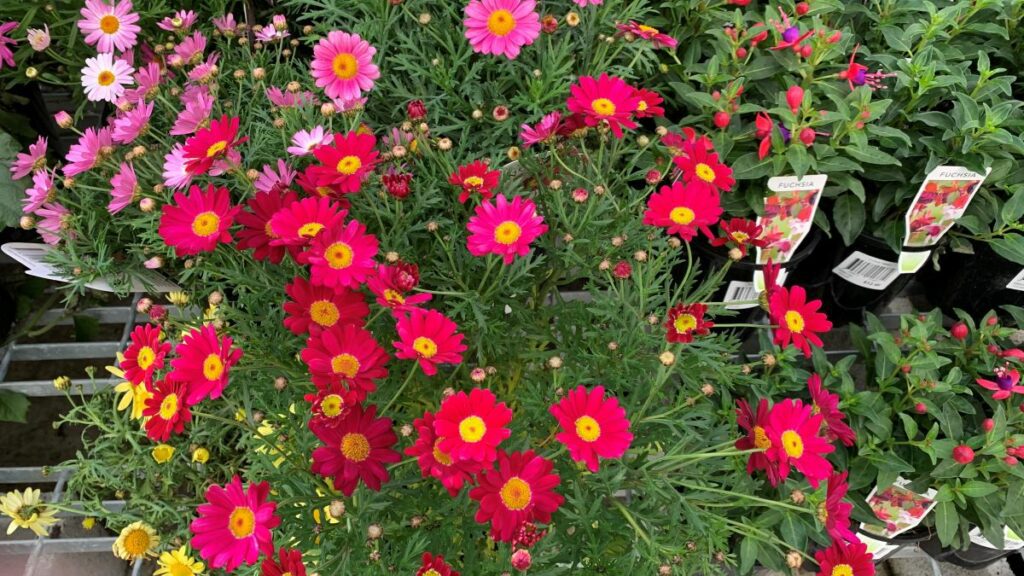The best place to put an insect hotel is a sheltered area out of the wind around 5-8 feet off of the ground. Keep bug houses in a place out of reach of dogs and cats and in an area that gets morning sun to prevent mold. Protect your bug hotel from rain by making it with a waterproof roof or place it under a garden shed verandah to attract beneficial insects.
This article will explore the best location to put an insect hotel in your backyard to keep it protected and safe for visiting insects.

The best place for your insect hotel | 5 Tips
Check out these easy tips to find the perfect location for your insect hotel. This will help to keep them protected from predators, prevent mold and will attract different types of insects to your bug house.
1. Find a spot with shelter
Place your insect hotel in a position that is sheltered from rain and wind. Keeping water off of the hotel will help to keep the insects home dry and will prevent mold forming over the winter months.
Insects will find a home in your hotel if it is well protected from the weather. They seek out dry and protected positions to make their nests. If you have lemon or lime trees, you can even hang your bug hotel under the protection of the canopy. Insects will be nearby to pollinate your lemon or lime tree in spring.
2. Place it 5-8 feet of the ground
Put your insect hotel in a safe place at least 5-8 feet off of the ground. This will keep it out of reach of cats, dogs, rats and mice.
This will make it easy for flying insects to make their way in and will keep natural predators like skinks and lizards out. You can attach the insect hotel to a tree, to your garden fence or even under a verandah.

Use cable ties or natural rope to attach the insect hotel high up. You can also use a nail and hang the insect house up in this position. Just make sure it doesn’t move in the wind as the insects will be less likely to land and build their nests.
3. Place it in a position that gets morning sun
Place insect hotel in a position that gets morning sun as this will help to prevent mold growth. Insects like to find a warm and protected position. Place the hotel east to north-east for a few hours of direct sunlight.
This will keep it in good condition for new insects to move into in the next season. You can even clean out your bug hotel year to year and remove old clay nesting material ready for new bugs to arrive. Just make sure the bugs have already left before you do this.
4. Place it near an existing tree
Placing your insect hotel near an existing tree or bush will make it easy for insects to transfer safely over to your insect house. Insects will find it easy to move and nest in your hotel.
You can attract native flies, wasps, moths and even bees if you place your hotel near a tree.
5. Keep it protected from cats and dogs
Finding the perfect position that keeps the bug hotel out of reach of cats and dogs is essential. They can easily knock the insect house off and disturb your insects if they can reach it.
Placing it above 5 feet will help to keep it out of reach of dogs. Make sure you keep it up and out of the way of areas that cats can climb.

How to attract bugs to an insect hotel
To attract a range of insect species to your bug hotel place it in a sheltered area, where it gets a few hours of morning sun and is protected from wind and rain. The perfect place for your bug hotel is 5-8 feet off of the ground in an area that is out of reach of dogs and cats. Beneficial insects like solitary bees and wasps will love your insect house and make it their own.
Check out these easy tips to attract more bugs to your insect hotel.
Plant a variety of flowers that attract pollinators
If you are keen on attracting pollinating insects to your hotel like bees then plant a variety of flowers for them to feed on.

Providing food for beneficial insects will encourage them to visit your garden and make a home in your insect hotel. Make sure that you have lots of flowers with plenty of pollen available for the pollinators. Here is the list of flower seeds included with my new insect hotel. Which provide lots of pollen for local bees.
- Calendula
- Cornflower
- Californian Poppy
- Fineflower
- Toadflax
- Alyssum
- Wallflower
- Nemophila
- Poppy
- Marigold
- Chinese Forget-Me-Not
- Borage
- Evening Primrose
- Lavender
- Native Violet
- Swan River Daisy
- Sage
Provide a water source nearby
Insects will be attracted to bug insect hotel they have a safe water source nearby. Wild bees in particularly will feel safe to make a home in your bug hotel if they have access to fresh water. Place a shallow saucer filled with water and a stone for the insects to land on. This will allow them to access the water without falling in. For more info, check out my article here on how to safely give water to bees.
Avoid Using Pesticides
To attract beneficial insects to your insect hotel avoid using pesticides in your garden. I use organic fertilizers and avoid pesticides at all in my garden to encourage a natural balance in bacteria and insects.
As the insects in your garden find balance, predatory insects like ladybugs and dragonflies will balance out any species trying to eat your plants like aphids.

Plant a range of flowers, herbs and vegetables in your garden with a diversity in foliage to encourage a range of insects to set up home in your backyard.
Make your insect hotel out of natural materials
If you are making an insect hotel at home make sure you choose natural materials. Use different materials like sticks, bark, straw and small branches. This will allow insects of all sizes to find a place to hide and find shelter. Make sure it has both big and small holes to cater for every insect that wants to call it their home.
If you are buying a bug hotel, look out for ones made of untreated timber, bamboo canes and natural materials like sticks, clay or timber. I chose a bamboo bug hotel because it has large and small holes and looks great against my wall.
Use different sized materials
Choose an insect hotel that has loads of different sized materials and holes for bugs to hide in. Tiny insects will love hiding among dry straw and hay while larger insects will make homes in the holes of bamboo. If you want lots of different bug species to visit your hotel, give them lots of different sized materials to hide in.
Insect hotels are a good idea for your backyard
Adding an insect house to your backyard is a good idea if you want to increase the population of insects including bees. Solitary wild bees will be happy to hide and nest in your hotel. A Bee hotel and bug hotel are similar and both with attract bees. Just make sure they have holes of different sizes to suit a wide variety of insects.
Insects are vital to the health of our backyards and local ecosystems. Insects are food for other animals, they pollinate our fruit and help to break down organic matter in our garden.

Adding an insect hotel to your garden is a great way to support our insect population providing them with shelter and structure to build their homes.
Some gardens can have limited places for bugs to set up their home so providing a bug hotel gives them extra real estate to live in. These are perfect for tiny urban gardens like mine as they can fill a vertical space up a wall that you aren’t using for anything else.
Insect hotels can be used in big backyards, tiny urban yards like mine or even balconies. There are lots of different ways to build these hotels and their design will affect the types of insects that will set up home in your insect hotel.
- Start small
- Use recycled materials
- Fill the hotel with different materials (bamboo canes, wood shavings, old sticks, folded bark or clay with holes) 3-10mm
How to choose an insect hotel
Make sure your insect hotel has a solid roof, otherwise it could fill with water and grow mold. I also chose one that had an enclosed back which provides more shelter for the bugs inside.
Choose a bug hotel to match your garden size. I have started with a small insect hotel for my tiny townhouse garden. If you have a bigger yard or a larger property you can build multiple insect hotels an stack them on top of each other as the first ones fill up.
What to put in insect hotels to attract insects
Insect hotels should be filled with small twigs, hollow bamboo canes, clay with holes or old wood. This will create the perfect home for a variety of insects giving them holes of different sizes to live in.
You don’t need to put anything extra in insect hotels to attract them. Insects will come and visit the hotel to nest and get shelter from rain and wind. If they find the right size hole, they may also nest and lay eggs.

Insects that live in an insect hotel
An insect hotel can become a home for solitary bees, ladybirds, spiders, flies or even wasps. You should check your insect hotel often to see what insects are living there. Insect hotels can be used as temporary shelter for visiting insects to escape rain and wind.
Even if they don’t set up a permanent home it can be a good refuge for a short time.
If you place your insect hotel on the ground you will attract ground dwelling insects and even small lizards and skinks. I hope to attract flying insects like bees and ladybugs so I have placed mine high on a ledge above my vegetable garden.
I have recently let my Pak Choi go to flower which has attracted bees to their yellow flowers. It will take a few weeks for insects to find and set up home in my insect hotel.
How to clean an insect hotel
If your insect hotel has become home to spiders or wasps over time you may need to clean the hotel out to make room for other visitors.
Clean your insect hotel simply using an old dustpan broom to remove old webs and dirt. Use gloves and take care that there isn’t anything still living in your insect hotel when you clean it.
If you find that wasps or bees have brought in mud or clay to close up the end of the holes, use a stick to clean them out. Make sure the bugs have left your hotel first before you do this and take care.
Benefits of an insect hotel
Insect hotels benefit the local insect population, the local ecosystem and your backyard. They will provide a home for visiting insects including pollinating insects like bees. These will help to pollinate fruit and flowers in our garden helping tomatoes, strawberries, lemons and apples to set fruit.
Our native bees colonies are declining so adding an insect hotel support them in our gardens will benefit them and us.
The insects will also an important food source for birds and lizards in your garden. Adding an insect hotel will benefit the natural ecology of your garden to grow and diversify.
Best place to put an insect hotel – Summary
Insect hotels will attract insects within 2-4 weeks if placed near your garden, in a protected area that gets afternoon shade. Protect the insect hotel from dogs, cats and rain and you will soon have a hotel full of insects.
I am an accredited practicing dietitian, experienced gardener and a dedicated cook. I love writing and sharing my experience so you can learn from my successes and mistakes.

Comments are closed.